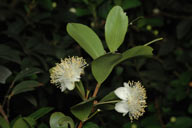In Flower This Week
A news sheet prepared by a Gardens' volunteer.
Numbers before each plant refer to temporary IFTW labels in the gardens.
Numbers in square brackets [ ] refer to garden bed Sections. Plants in flower are in bold type.
View past issues of 'In Flower This Week'.
18 February 2015
Pilidiostigma rhytispermum click for larger image |
We will walk along the Main Path today.
- On the far left as you leave the Visitor Information Centre (VIC) is Correa alba [Section 221], or White Correa, a shrub with creamy-white bell flowers on dull green silver-backed foliage. In the wild it is found in coastal regions of south-eastern Australia.
- On the near left as you leave the VIC in a pot is Pilidiostigma rhytispermum [Section 221], or Small-leaved Plum Myrtle, a medium woody shrub with small leaves and cream cup-shaped flowers. The black fruits are attractive to many fruit-eating birds. This plant is found in the wild along the coast of southeastern Queensland.
- On the right of the VIC, also in a pot, is Prostanthera densa [Section 221], or Villous Mintbush, a stiff, angular plant with pale green leaves and mauve flowers with orange markings. This plant is native to coastal New South Wales, both north and south of Sydney.
- Skirt in front of the café to see on your left Banksia ‘Stumpy Gold’ [Section 131], with fine, toothed linear foliage and short gold brush-like flower heads. This plant is a dwarf cultivar of Banksia spinulosa var. collina that was selected by Richard Anderson of Merricks Nursery in Victoria from material collected on the New South Wales central coast.
- Further on your left is Epacris longiflora [Section 131], a prickly bush with red tubular flowers with white tips. The native range of this plant extends from the central coast of New South Wales to southern Queensland.
- Correa ‘Summer Belle’ [Section 240], on the right, is a small plant with reddish bell flowers with green tips. This cultivar originated from a garden seedling from Neil Marriott of Stawell, Victoria.
- Callistemon viminalis [Section 310], on your right, is a medium-sized tree with drooping foliage and brilliant red brush-like flowers. This plant is also known as Weeping Bottlebrush, and often grows along watercourses in its native New South Wales and Queensland.
- Turn up the hill to see on your left Eremophila oldfieldii subsp. angustifolia [Section 302], with fresh green linear foliage and bright salmon pink tubular bell flowers with prominent sepals. This shrub occurs naturally in southwestern Western Australia.
- Banksia spinulosa ‘Birthday Candles’ [Section 30], on your left, is coming into bloom with striking pale gold flower heads and bright green linear foliage. Thisis a dwarf cultivar of Banksia spinulosa var. spinulosa developed by Bill Molyneux of Austraflora Nurseries in Montrose, Victoria.
- On your right is Grevillea sericea [Section 26], with pink spider flowers on a long-flowering open bush. This plant is endemic to New South Wales.
- On the right is Persoonia lanceolata [Section 26], a dense bush with small leaves and tiny yellow-gold flowers. It is commonly known as Lance-leaf Geebung, and is native to coastal New South Wales
- On your right is Banksia conferta subsp. penicillata [Section 26], or Newnes Plateau Banksia. Its flower heads open as thin ginger-brown cones, and as the flowers develop these become larger lime-green cones with a velvety “nose” peeking through at the top.
- Grevillea manglesii subsp. manglesii [Section 24], or Birdsfoot Grevillea, is a large open bush with pincushion-like white flower heads all along the stems. It is native to Western Australia.
- Further on your left is Adenanthos × cunninghamii [Section 24], with beautiful soft silver foliage and tiny red flowers.
- Correa ‘Marian’s Marvel’ [Section 112], on your right, is a medium-sized dense bush with pale pink and green bell flowers. This beautiful plant is a cross between Correa reflexa and C. backhouseana.
Rosalind Walcott
![Director of National Parks [logo]](../../../../images/dnp_90px.gif)







